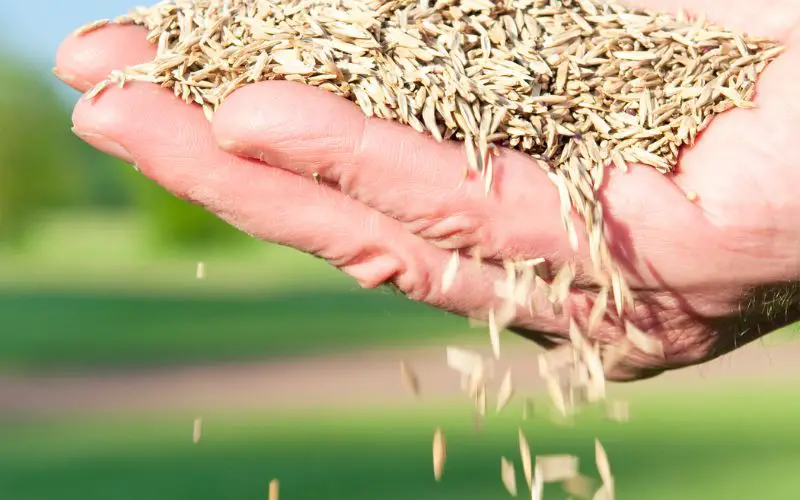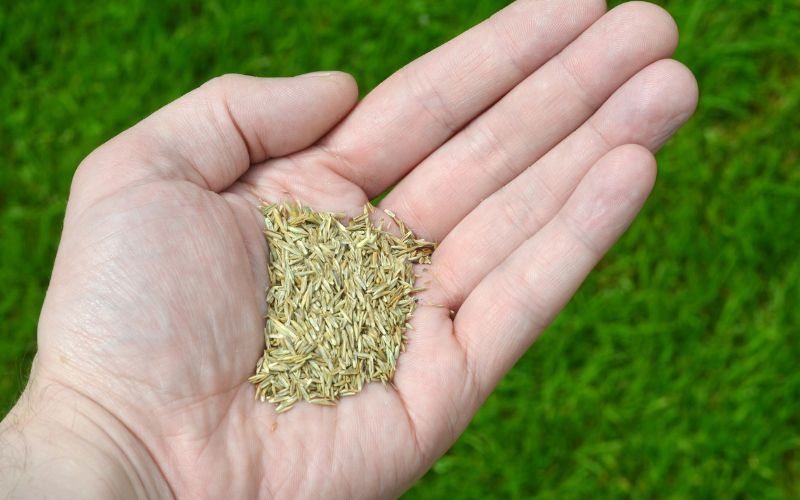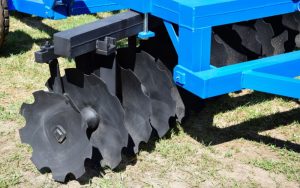Have you ever thought about just throwing grass seed down on your lawn and letting nature take its course?
While this may seem like a viable option, there are actually several reasons why you shouldn’t just toss grass seed down on your existing lawn.
Before you seed your lawn it is important to do some easy preparation that will give your new seeds the best possible opportunity to grow well. If you simply toss the seed onto the existing lawn you’ll find that you will get poor results.
Reasons why you shouldn’t just throw grass seed down on your lawn
The grass seed may not take root
If you’re just tossing the grass seed down on top of the soil, there’s a good chance that the seed won’t actually take root.
The seed needs to come into contact with bare soil in order to germinate and grow.
Otherwise, it will just sit on top of the ground and eventually die.
The existing grass may crowd out the new grass seedlings
If you have an existing lawn, chances are that the grass is already fairly thick.
When you add more seed to the mix, the existing grass will crowd out the new seedlings and prevent them from getting the sunlight and water they need to grow.
This can also lead to patchy growth.

You could end up with more weeds than before.
Weeds love nothing more than an opportunity to take over your lawn.
If you just throw down some seed without taking proper precautions, you could end up with more weeds than you started with.
Weeds can quickly choke out young grass seedlings, so it’s important to be careful when adding new seeds to your lawn.
How to use your new grass seed
If you want to successfully add new grass seed to your lawn, we recommend taking the following steps:
Remove any dead grass or debris from your lawn.
This will help ensure that the new seed has direct contact with bare soil.
Aerate your lawn before adding new seed. This will help loosen up packed soil and improve drainage.
Aeration allows water, air, and nutrients to reach the roots of your grass more easily.
If your lawn is heavily compacted, the grass won’t be able to develop deep roots, which means it will be less resilient and more susceptible to drought and pests.
There are two types of aeration – mechanical and manual.
Mechanical aeration is done with a machine that punctures holes in the soil.
Manual aeration is done with an aerating fork or spike shoes.
If you have a small lawn, manual aeration might be all you need.
But if you have a large lawn, mechanical aeration will save you a lot of time and energy.
Choose the right grass seed
The next step is to choose the right grass seed for your lawn.
The type of grass you choose will depend on several factors, including your climate, soil type, and how much sun and shade your lawn gets.
If you’re not sure what type of grass would be best for your lawn, talk to a local nursery or landscape professional.
They’ll be able to recommend the best type of grass seed for your particular situation.
Sowing the seed
Once you’ve chosen the right type of grass seed, it’s time to sow it.
The best time to sow grass seed is in early spring or late summer/early fall.
If you sow the seed too early in spring, cold temperatures could delay germination or kill the seeds outright.
And if you sow the seed too late in fall, winter temperatures could also delay germination or kill the seeds outright.
When sowing grass seed, make sure to spread it evenly over the entire area that you want to cover.
You can use a spreader for larger areas or simply scatter the seed by hand for smaller areas.
Once you’ve sown the seed, lightly rake it into the soil so that it has good contact with the ground.
Keep the seed watered
One of the most important things to do when growing new grass seed is to water it regularly.
You should water new grass seed at least once a day, and more if necessary, in order to keep the soil moist.
If the soil dries out, the seed may not germinate, or it may die before it has a chance to take root.
Additionally, newly seeded grass needs to be watered more frequently than mature grass, as it is still developing its root system.
By watering regularly, gardeners can ensure that their new grass seed has the best chance of germinating and growing into a healthy lawn.
Water regularly until the new grass reaches a height of 3-4 inches.
After that, you can begin mowing at your usual height.
Final Words
Adding new grass seed to your lawn can be a great way to improve its appearance.
By following the steps outlined above, you can ensure that your new grass seed has the best chance of germinating and taking root.
With a little time and care, you’ll have a lush, green lawn that you can enjoy for years to come.










